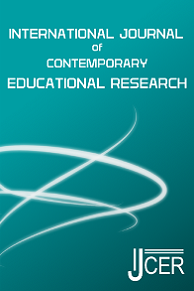Improving Listening Skills with Extensive Listening Using Podcasts and Vodcasts
DOI:
https://doi.org/10.33200/ijcer.685196Keywords:
Extensive listening, L2 listening skills, Podcast, VodcastAbstract
The present study investigated the potential of podcasting and vodcasting technology in promoting extensive listening and improving overall L2 listening skills. Forty-nine college-level EFL students took part in this year-long study. Data, coming from listening log assignments, listening progress tests, proficiency tests and a listening log questionnaire, were both quantitatively and qualitatively analyzed and interpreted. Results show that students spent approximately one hour per week on extensive listening with podcasts or vodcasts outside the classroom. Vodcasts were found to be less commonly preferred than podcasts by students. Further, as measured by listening progress tests and proficiency tests, students were able to make significant progress in their overall listening skills by the end of the year. Additionally, students found extensive listening practice with podcasts and vodcasts highly effective not only in helping them improve as L2 listeners but also enhancing their pronunciation abilities and knowledge of words and phrases. Yet, students reported being occasionally frustrated with the pace of speech in podcasts and vodcasts. Overall, this study suggests that developing certain language skills can be boosted with digital technologies at our fingertips.
References
Abdous, M. H., Camarena, M. M., & Facer, B. R. (2009). MALL technology: Use of academic podcasting in the foreign language classroom. ReCALL, 21(1), 76-95.
Alm, A. (2013). Extensive listening 2.0 with foreign language podcasts. Innovation in Language Learning and Teaching, 7(3), 266-280.
Bakla, A. (2018). Can podcast provide meaningful input in a listening and pronunciation class? Kuramsal Eğitimbilim Dergisi, 11(4), 772-788.
Berne, J. E. (2004). Listening comprehension strategies: A review of the literature. Foreign Language Annals, 37(4), 521-531.
Brown, S. (2011). Listening myths: Applying second language research to classroom teaching. Ann Arbor: University of Michigan Press.
Burston, J. (2015). Twenty years of MALL project implementation: A meta-analysis of learning outcomes. ReCALL, 27(1), 4-20.
Chan, W. M. (2014). Video podcasting as a supplementary language learning tool–A study of its use, student access and perceptions. Electronic Journal of Foreign Language Teaching, 11(1), 183-206.
Chang, A. C., & Millett, S. (2014). The effect of extensive listening on developing L2 listening fluency: Some hard evidence. ELT Journal, 68(1), 31-40.
Chen, C. W. Y. (2019). Guided listening with listening journals and curated materials: A metacognitive approach. Innovation in Language Learning and Teaching, 13(2), 133-146.
Creswell, J. W. (2012). Educational research: Planning, conducting, and evaluating quantitative (4th edition). Upper Saddle River, NJ: Prentice Hall.
Dupugne, M., Milette, D.M., and Grinfeder, K. (2009). Effectiveness of video podcast use as a revision tool. Journalism and Mass Communication Educator, 64, 54-70.
Faramarzi, S., Tabrizi, H. H., & Chalak, A. (2019). The effect of vodcasting tasks on EFL listening comprehension progress in an online program. International Journal of Instruction, 12(1), 1263-1280.
Gonulal, T. (2019a). The development and validation of an attitude towards MALL instrument. Educational Technology Research and Development, 67(3), 733-748.
Gonulal, T. (2019b). The use of Instagram as a mobile-assisted language learning tool. Contemporary Educational Technology, 10(3), 309-323.
Gonulal, T. (2019c). Missing data management practices in L2 research: The good, the bad and the ugly. Erzincan University Education Faculty Journal, 21(1), 56-73.
Gonulal, T. (2019, November). Learning languages inforMALLy: An investigation into the effectiveness of MALL and MALL apps. Paper presented at the 19th INGED ELT Conference, Ankara, Turkey.
Kukulska-Hulme, A. (2009). Will mobile learning change language learning? ReCALL, 21(2), 157–165.
Kukulska-Hulme, A. (2012). Mobile-assisted language learning. In C. Chapelle (Ed.), The encyclopedia of applied linguistics (pp. 3701-3709). New York: Wiley.
Merzifonuoğlu, A., & Gonulal, T. (2018). Book review: M Carrier, RM Damerow and KM Bailey (Eds). Digital language learning and teaching: Research, theory, and practice. Language Learning & Technology, 22(1), 65-68.
Nunan, D. (2002). Listening in language learning. In J. C. Richards & W. A. Renandya, (Eds.), Methodology in language teaching: An anthology of current practice (pp. 238-241). Cambridge: Cambridge University Press.
Renandya, W. A., & Farrell, T. S. (2011). ‘Teacher, the tape is too fast!’ Extensive listening in ELT. ELT Journal, 65(1), 52-59.
Rodgers, M.P.H. (2016). Extensive listening and viewing: The benefits of audiobooks and television. The European Journal of Applied Linguistics and TEFL, 5(2), 43-57.
Rost, M. (2001). Teaching and researching listening. London: Longman.
Rost, M. (2006). Areas of research that influence L2 listening instruction. In E. Usó-Juan & A. Martínez-Flor, (Eds.), Current trends in the development and teaching of the four language skills (pp. 47-74). Berlin: Mouton de Gruyter.
Schafer, J. L. & Graham, J. W. (2002). Missing data: our view of the state of the art. Psychological Methods, 7(2), 147-177.
Schmidt, A. (2016). Listening journals for extensive and intensive listening practice. English Teaching Forum, 54(2), 2-11.
Schreier, M. (2012). Qualitative content analysis in practice. Thousand Oaks, CA: Sage.
Shelly, G. B., & Frydenberg, M. (2010). Web 2.0: concepts and applications. Boston: Cengage Learning.
Siegel, J. (2012). Second language learners’ perceptions of listening strategy instruction. Innovations in Language Learning and Teaching, (7)1, 1-18.
Siegel, J. (2014). Exploring L2 listening instruction: Examinations of practice. ELT Journal, 68, 22–30.
Stanley, G. (2006). Podcasting: Audio on the Internet comes of age. TESL-EJ, 9(4), 1-7.
Stockwell, G. (2008). Investigating learner preparedness for and usage patterns of mobile learning. ReCALL, 20(3), 253-270.
Stockwell, G., & Hubbard, P. (2013). Some emerging principles for mobile-assisted language learning. Monterey, CA: The International Research Foundation for English Language Education. Retrieved from http://www.tirfonline.org/english-in-the-workforce/mobile-assisted-language-learning
Vandergrift, L. (2007). Recent developments in second and foreign language listening comprehension research. Language Teaching, 40(3), 191-210.
Vandergrift, L., & Goh, C. C. (2012). Teaching and learning second language listening: Metacognition in action. New York: Routledge.
Winn, R. (2020, January 28). 2020 podcast stats & facts. Retrieved from https://www.podcastinsights.com/podcast-statistics/
Yeh, C-C. (2013). An investigation of a podcast learning project for extensive listening. Language Education in Asia, 4, 135-149.
Downloads
Published
How to Cite
Issue
Section
License
Copyright (c) 2022 Talip Gonulal

This work is licensed under a Creative Commons Attribution-NonCommercial 4.0 International License.




